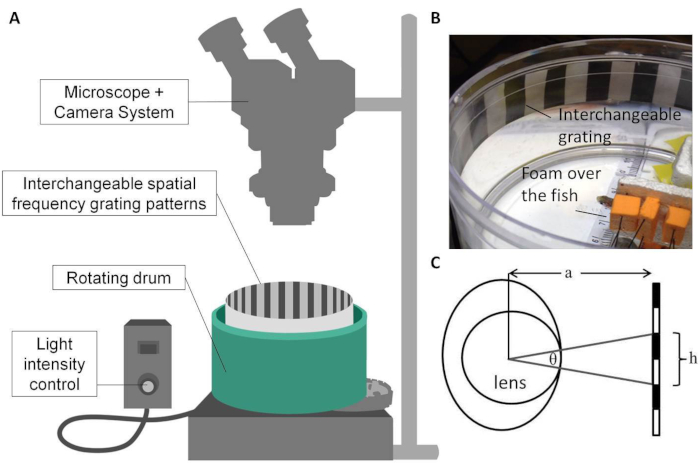Optokinetic Response Assay: A Method to Measure Visual Acuity in Zebrafish
Abstract
Source: Cameron, D. J., et al. The Optokinetic Response as a Quantitative Measure of Visual Acuity in Zebrafish. J. Vis. Exp. (2013)
This video describes the optokinetic response assay in zebrafish. The video measures the reflexive eye movements based on the visual moving stimulus and determines the visual acuity in zebrafish.
Protocol
1.Optokinetic response (OKR)
- Build the custom OKR recording device using a 14.5 cm diameter rotating drum, a stereo microscope with adjustable light intensity settings (300-8,000 lux) and a computer (Figure 1A).
- Attach a camera to the microscope that will provide a live feed onto an adjacent monitor and allow for image capture and recording.
- Control the rotating drum using a microcontroller linked to a computer which will accommodate various speed and direction selections.
- Anesthetize the fish in 0.016% tricaine for 2-3 min and then place the fish on a small platform with the eyes and gills suspended over the edge.
- Place a thin sponge/towel over the body of the fish and pin 2-3 pieces of foam, shaped to accommodate the fish, over the fish to keep it immobilized. Limiting the movement of the tail of the fish was found to be a crucial aspect for immobilization without causing injury to the fish, and was best achieved using a flat piece of foam. (Figure 1B)
- Position the fish within a cylindrical water-filled tank, that fits inside the rotating drum of the OKR recording device. Use magnets on the platform to position the fish upright, with the eyes approximately 7.3 cm from the edge of the drum. The fish should revive from the anesthesia within a few minutes – normal breathing will resume and random eye movements should be observed.
- Place a base grating of 0.07 cycles per degree (cpd) into the rotating drum and engage the computer controls to begin rotation and video capture (a speed of 12 rpm was used for this paper, but speeds of 8-16 rpm should give similar results).
- Once an initial OKR is elicited by the base grating, pause the rotation briefly, and replace the grating with a smaller grating (higher spatial frequency).
- Repeat this process until an OKR can no longer be elicited. Retest with the smallest grating that caused an OKR following a modified staircase approach and then repeat using the grating that failed to elicit a response to verify the loss of the OKR. This process may be repeated to verify a true response to the smallest detectable grating if the final grating changed relative to the first extinction event.
- Obtain monocular acuity measurements by placing a black plastic occluder over the stripes adjacent to the opposite eye. Repeat the procedure above (steps 1.6-1.7).
- Obtain the acuity of the opposite eye by repositioning the occluder and repeating the steps 1.6-1.7 again.
- Note the distance each eye is from the stripes during the testing procedure by using the reference measuring strip beneath the fish tank so that accurate acuity measures can be calculated in the following steps.
2. Calculating Visual Acuity
- Obtain the visual acuity by calculating the cpd:
 where a is the distance from the center of the lens to the grating, and h is the length of one cycle of the smallest grating at which OKR was observed (Figure 1C).
where a is the distance from the center of the lens to the grating, and h is the length of one cycle of the smallest grating at which OKR was observed (Figure 1C). - For combined visual acuity measurements, the averaged a-value from both the left and right eye is used.
Representative Results

Figure 1. OKR recording. A) The OKR device consists of a 14.5 cm diameter rotating drum and microscope with adjustable light intensity settings (300-8,000 lux). A camera provides a live feed on an adjacent monitor. The rotating drum has various speed settings in both clockwise and counterclockwise directions and interchangeable spatial frequency gratings are inserted and removed as needed. B) Fish are secured and placed in the center of the rotating drum. C) Cycles per degree (cpd) is calculated using cpd=
Materials
| Super Low Light Black White Video Security Camera | Super Circuits | PC164CEX-2 | Any low light camera may be used |
| Arduino Duemilanove microcontroller | Adafruit Industries | The Arduino Uno is also compatible with the speed control software. | |
| Tricaine Methanesulfonate | VWR | 101107-950 |

